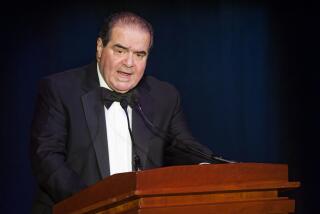MAY IT PLEASE THE COURT: The First Amendment.<i> Edited by Peter Irons</i> .<i> The New Press: 262 pp., $59.95 with four 90-minute cassettes narrated by Peter Irons</i>
Four years have passed since Peter Irons published his initial series of 23 edited Supreme Court oral arguments that, for the first time, brought into our living rooms the voices of justices and lawyers coming to grips with the nation’s most important legal issues. At the time, I criticized Irons in the Atlantic Monthly for “fictionalizing” the arguments. Cutting and splicing, he had so shuffled the order of questions and answers and distorted speeches that the final product bore little resemblance to what actually happened in the courtroom. I also suggested that Irons’ editing gave the tapes a political skew, prettying up the arguments of liberals like himself while dumbing down those of conservatives.
Now, Irons is back with another tape collection, this one compiling 16 arguments from cases involving the 1st Amendment. In a throat-clearing introduction, Irons addresses “a few critics” who had taken him to task for his editing techniques. This time, Irons promises, things are different: “The excerpts of every argument in this collection are presented in temporal order.”
A lawyer would point out that this is a very narrow warranty. In the interest of what Irons calls “clarity or coherence,” he still lets himself electronically assemble uninterrupted speeches from sentences that were spoken minutes apart; it’s just that now he promises to keep the false juxtapositions in temporal order. Moreover (as in the original set), Irons masks his editorial hand by generally refusing to use ellipses in his accompanying transcripts to alert the reader/listener to differences between actual history and his Memorex finagling.
Worse yet, Irons’ limited claim to have restored the “temporal order” of the arguments is not even true. Take Texas vs. Johnson, in which the court ruled that state governments may not criminalize the act of burning an American flag. In Irons’ version, the late William Kunstler (counsel to flag-burner Gregory Lee Johnson) delivers a series of long, seamless speeches. Actually, none of Kunstler’s speeches happened quite as Irons’ tape would suggest, and one of these set pieces is pure concoction. In Irons’ version, it consists of three uninterrupted paragraphs where Kunstler explores what is meant by a “flag.” In real life, these paragraphs were uttered minutes apart, in separate contexts, and definitely not in the sequence of Irons’ presentation. Checking the Supreme Court’s official transcript, the first paragraph of Kunstlers’ seemingly unified “speech” appears on page 30, the second paragraph on page 39 and the third paragraph on page 35.
It is impossible to know without traveling to the Supreme Court library whether Irons’ handling of Texas vs. Johnson is an aberration or, as before, part of a larger pattern of distortion. What can be known with certainty is that the rather eloquent argument Kunstler makes on Irons’ tape differs radically in tone and tenor from the rambling and sometimes offensive argument Kunstler actually delivered. For Irons, ensuring a good listen evidently trumps his obligation to accurately portray events.
Granted, there is good listening here. Irons’ greatest hits of the modern 1st Amendment succeed in covering many of the major principles undergirding our freedom of speech, religion and the press. Chronologically, the tapes span from the 1963 argument in Abington Township vs. Schempp, in which the court banned prayer in public schools, through the many 1st Amendment crises of the Vietnam and civil rights era, up to the court’s 1995 decision allowing the organizers of a St. Patrick’s Day parade to exclude gay rights activists from their ranks.
Along the way, the listener is treated to both the sublime and the ridiculous. At one end of the spectrum, we hear Alexander Bickel, one of the century’s great constitutional scholars, sparring with Justice Hugo Black in the Pentagon Papers case over whether the 1st Amendment’s admonition, “Congress shall make no law respecting freedom of speech,” can be taken literally. At the other end, we get the voyeuristic pleasure of hearing the justices argue about whether nude dancing conveys a sufficiently artistic message to merit 1st Amendment protection.
My own favorite exchange occurs at the outset of Cohen vs. California, a Vietnam era case raising the question whether Paul Robert Cohen, a 19-year-old store clerk, could be prosecuted for wearing a jacket inscribed with the words “F--k the draft.” Chief Justice Warren Burger, who was such a stickler for propriety that he once turned his back on a female lawyer because she wore a pantsuit to oral argument, was extremely concerned that the jacket’s offending message not be uttered in the Supreme Court’s august chamber. Accordingly, he admonished Cohen’s attorney, Melville Nimmer, to move quickly past the facts of the case to his legal argument.
Nimmer’s reply has become court legend. “At the chief justice’s suggestion,” he began, “I certainly will keep very brief the statement of facts. . . . What this young man did was to walk through a courthouse corridor in Los Angeles County, on his way to a courtroom where he had some business. While walking through that corridor, he was wearing a jacket on which were inscribed the words, ‘F--k the Draft.’ ”
These small delights, however, mask a deeper problem with Irons’ tapes. By Irons’ own account, his tape collections are intended primarily as a teaching tool for explaining the court and constitutional law. This enterprise calls for a careful and sophisticated narrator to guide students through the complex shoals of the court’s work. Regrettably, Irons is neither.
At the conclusion of every oral argument excerpt, Irons (as narrator) interjects a summary of the result and reasoning behind the court’s eventual ruling in each case. This is a fine idea and a golden pedagogic opportunity. Irons, though, shows no feel for the nuances and technicalities of the constitutional lawmaking and, as a result, his narration too often misleads.
A case in point is Irons’ treatment of County of Allegheny vs. ACLU, an important 1989 decision about whether religious displays or public property violate the Constitution’s ban on government “establishment” of religion. At issue in Allegheny were two displays: a Christian nativity scene placed on the grand staircase of the county courthouse and a holiday display outside the county administrative building that included a Christmas tree, a menorah and a large sign declaring the city’s holiday season a “salute to liberty.”
In deciding the case, the court splintered badly. Four justices wanted to allow both holiday displays. Three justices wanted to allow neither. Justices Harry Blackmun and Sandra Day O’Connor, holding the swing votes, wanted to allow the tree-menorah-sign display but ban the nativity scene. In similar yet separate opinions, both Blackmun and O’Connor used a legal test O’Connor had pioneered: Did the displays convey a governmental “endorsement” of religion? And for both justices, the presence of the secular sign saluting liberty was crucial to their conclusion that the tree-menorah-sign display (unlike the nativity scene) conveyed no such endorsement, and was, therefore, constitutional.
In describing the court’s ultimate decision, Irons gets the line-up of justices wrong, mistakenly putting O’Connor in the category of those who would have allowed both displays. This is especially egregious given that her views were decisive in the case. Irons’ narration also fails even to mention the liberty sign that was essential to the court’s ruling. Of course, only scholars would notice such errors and omissions, but teaching materials ought to get the central facts right. Irons doesn’t.
Such particularized mistakes are compounded by an overall thoughtlessness. Many of the cases in the 1st Amendment collection are related. For example, Tinker vs. Des Moines, in which the court upheld the right of students to wear black armbands to protest the Vietnam War, was crucial to the argument of two decades later, in Hazelwood School District vs. Kuhlmeier, in which the court allowed school officials to censor a high school newspaper. Similarly, in deciding Texas vs. Johnson, upholding the right to burn the flag, the late Justice William Brennan had to write his way around another case in the collection, United States vs. O’Brien, in which the court allowed prosecutions for burning draft cards. These vital links--the connective tissues that join separate cases into coherent legal doctrine--find no place in Irons’ narration. Often, Irons doesn’t even pair related cases on the same cassette.
In short, the Supreme Court tapes are a wonderful idea that disappoints in the execution. For this, the court itself deserves some blame. In 1974, the distinguished constitutional lawyer Jack Greenberg (recently dean of Columbia University) asked the court’s cooperation in publishing a “balanced” and “accurate” series of edited oral arguments. The justices, quite brusquely, turned him down, thus leaving the endeavor to someone (like Irons) who would act without their permission. The listening public now suffers for the court’s shortsighted choice.


